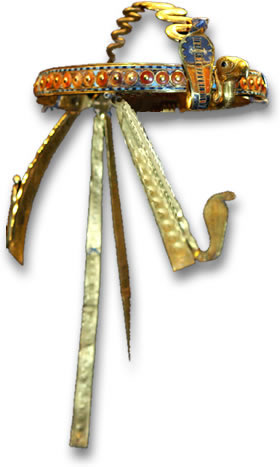Your Details
Your Details
|
Reviewed By Andreas Zabczyk
King Tutankhamun's Tomb of Treasures The Gold Diadem of King Tutamkhamun
One of the most exciting historical discoveries of all time was the tomb of Pharaoh Tutankhamun in 1922 by Howard Carter. King Tutankhamun's tomb in the Egyptian Valley of the Kings was so well preserved that it took 10 years for Carter to clean and list its several thousand contents. The ancient Egyptians mummified the remains of pharaohs and surrounded them with riches for use in the afterlife in their final resting place. King Tutankhamun, or "King Tut" for short, was known as "the boy king" who ruled for about 10 years from around 1336 BC until his death at the approximate age of 17. There have been several theories about the cause of his death, the latest of which is that King Tut died from an infected leg injury. The reason for his death is not clear, but it is known that King Tut died unexpectedly, since his tomb was prepared hurriedly and later lost in the sands of time until Howard Carter's discovery. The most important item in the tomb of King Tut was the nest of coffins that fitted inside each other. The final coffin was made from solid gold and weighed about 110 kilograms. It was made in the image of the Egyptian king and inlaid with lapis lazuli, carnelian and other materials. The eyes were made from calcite and obsidian. One of the most iconic images associated with ancient Egypt is the gold death mask of Tutankhamun. The mummified body inside had numerous layers and within the layers of bandages were a large number of amulets and other objects.  Vulture and Cobra with Gemstone Inlay
On his head, the pharaoh wore a gold crown. The front of King Tut's crown features a vulture, representing the goddess Wadjet, who ruled over Lower Egypt, and a cobra representing Nekhbet, who protected Upper Egypt. These symbolize King Tut's reign over Egypt. The eyes of the vulture are made of obsidian, a type of volcanic glass. The cobra has lapis lazuli, faience, glass and carnelian inlay. Adorning the neck of King Tut were an array of exquisite amulets delicately suspended on gold wires and cords. Among these precious adornments were captivating pieces crafted from green feldspar, carnelian, red jasper, and lapis lazuli. The pharaoh's regal ensemble extended beyond his neck, as he also sported rings, bracelets, and an assortment of other ornamental treasures. Remarkably, even within the layers of the mummified remains, amulets fashioned from gemstone beads and gold were discovered, carefully wrapped and preserved. The meticulous documentation by Howard Carter revealed a staggering collection of over a hundred objects that were entombed alongside the illustrious King Tut, each bearing witness to the opulence and grandeur of ancient Egyptian royalty. In addition to the items found within the bandages of the mummy of King Tut, there were many items of jewelry and other objects found in each of the chambers of his tomb. One interesting item found in a chamber of King Tut's tomb was a pectoral decoration with a yellow-green scarab gemstone in the center. The gemstone was originally thought to be chalcedony, but was later revealed to be a form of natural glass known as silica glass. The silica glass is believed to have formed due to a meteor or comet that crashed in the Sahara Desert.  Silica Glass Scarab from King Tut's Pectoral
The scarab is less glamorously known as the dung beetle. For the ancient Egyptians, the scarab beetle symbolized creation and was associated with the sun-god, Khepri, who rolled the sun across the sky every evening and emerged anew every morning, as the dung beetle rolls dung balls into places from which baby beetles later emerge anew. Ancient Egyptian scarab amulets were made from a variety of materials, which included carnelian, lapis lazuli, malachite and turquoise. The numerous priceless treasures of King Tut sparked an international interest in all things Egyptian and influenced art and jewelry in the 1920s and for many years thereafter. Indeed, one can only gaze with awe at such relics. They are the most famous artifacts in the world and some of them have traveled the globe to be exhibited. However, the original items are now housed at the Egyptian Museum in Cairo where they will stay for the people of Egypt and tourists alike to admire for many years to come. |
